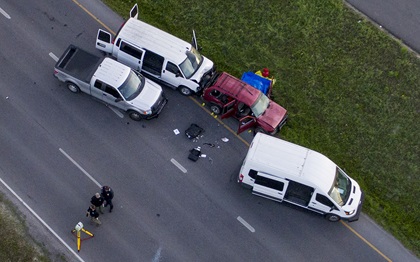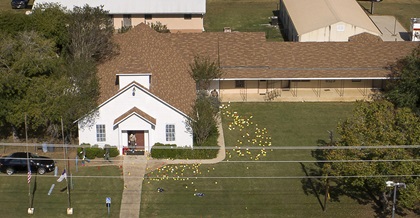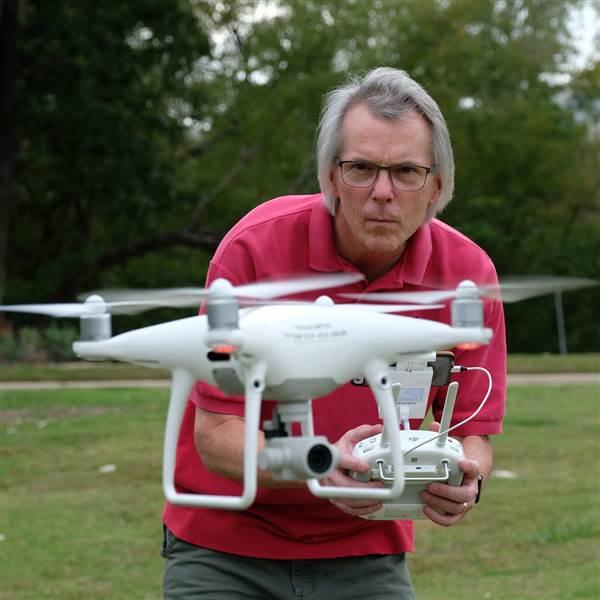Rise of the news drones
Aerial storytelling within reach
Once the exclusive domain of large-market television stations with pockets deep enough to hire helicopters, consumer quadcopters have democratized aerial journalism with affordable access to previously unseen perspectives on disasters, major crimes, and much more.
Sometimes the aerial perspective has obvious value. Think about the barricaded suspect surrounded by SWAT officers; the raging factory fire; or widespread, devastating floods, wildfires, or tornado strikes. Journalists call this “spot” or “breaking news,” and these are the kinds of stories most likely to have helicopters assigned.
Outside of huge stories, newspapers did not historically have much appetite (or budget) for helicopter rental.
Justifying the expenditure of hundreds or thousands of dollars required compiling an aerial wish list, inviting editors around the newsrooms to pencil in assignments, and wait until the list got long enough to justify a photo flight. Some might split rental costs with another news organization. (Television stations also came to do this routinely—have you seen the news helicopters with one station’s livery painted on one side, and another station on the other?)
Lining up good weather, an available helicopter, and the right journalist to fly (not everyone takes well to flight assignments) could be a challenge. Television stations with their own helicopters were typically up at least twice a day to eyeball traffic and flaunt their competitive capabilities, but they too were mindful of the cost of flying. That’s why many TV news crews now carry drones. Besides being much cheaper to operate than a helicopter, drones are sometimes the better platform for safety and access considerations.
They can be airborne in a minute, and many good aerial photos can be taken at low altitude, 50 to 75 feet. Sustained helicopter operation at these altitudes is risky and intrusive, in addition to being expensive.
Being a professional news gatherer employed by an accredited media outlet confers zero special privileges when it comes to flying. Working journalists are but a tiny fraction of the more than 333,000 Part 107 certificated remote pilots. They must follow the same rules as any other remote pilot flying under Part 107, and apply for the same FAA waivers if and when needed. While only the FAA regulates the National Airspace System, state and local municipalities can and do make their own regulations around drone use. Depending on the state, these can restrict how a news drone might be used in any market, if at all.
A journalist flying a drone needs to be especially mindful of airspace, privacy considerations, temporary flight restrictions, special-use airspace, controlled airspace, and physical obstructions. Because a drone journalist is typically not flying at the behest of a property owner, they also need to consider that what might be fair game and legal from a helicopter is not always so from a drone. Takeoff and landing from public property are generally allowed, but private landowners have the right to withhold permission, and many do. The familiarity with the local area in which they work that develops over time serves visual journalists well when it comes to choosing a landing zone.
Though there are no exact numbers on what percentage of daily newspapers and television stations own or contract a drone, specific media training is plentiful and popular. Many collegiate journalism curricula now include drone education as part of the traditional suite of reporting, writing, photography, and ethics mainstays.
The Poynter Institute in Florida, whose mission is to support responsible journalism through education, has offered Part 107 training classes as well as a drone photography course. In 2017, a Poynter class of around 300 was a nearly even mix of television and newspaper journalists, and 120 of the attendees obtained their Part 107 certificate after the training.
Gannett, parent of USA Today and owner of more than 100 local media organizations around the country, has a very specific, safety-focused approach to drone journalism. All Gannett drones are operated by a team of two, a pilot and visual observer who doubles as a camera operator. The Corpus Christi Caller-Times began its drone program in early 2017, and like all Gannett-owned organizations, the staff was given intensive training on all aspects of drone operation. Caller-Times journalist and newsroom lead coach Chris Ramirez is typically the pilot half of his team, while a second staffer, a more seasoned photographer, operates the camera.

Other media organizations are comfortable with single-pilot operations for most assignments, using simpler drones like the ubiquitous DJI Phantom 4 Pro or the new Mavic 2 Pro. The Austin American-Statesman is an example, with more than 400 drone launches over two years covering everything from cook-offs and aerial views of the ordinary to Hurricane Harvey and the capture of a local bomber that claimed national headlines.
Staff photojournalist Jay Janner has the drone with him whenever he is on duty, and the Texas summer heat can make it challenging to keep that gear properly cooled. Janner likes to include Google Earth as part of his preplanning of routine flights, so that he knows the flight environment and can visualize what his drone view will look like. This minimizes time aloft. On some missions, he enlists a visual observer, and he never lets urgency of news or the potential of a good aerial view trump safety.
So why doesn’t every news organization operate a drone? Al Tompkins, Poynter Institute senior faculty and certificated remote pilot, said there can be several reasons. A media organization’s most photogenic opportunities might lie in airspace that is problematic, or off-limits entirely. Ramirez puts a point on that, in describing the Caller-Times’ situation: “We’re really confined in the city limits as far as airspace. Our international airport is a couple miles away from downtown. We also have a military Naval Air Station that frequently flies maneuvers, often at really low elevations. It’s hard at times to respond to breaking news.”
As a result, many of the Corpus Christi team’s flights are planned around enterprise reporting and features. The drone team tries to fly at least once a week. Many of the first aerial images of Hurricane Harvey’s impact on the Texas coast came from the Gannett-Corpus team.
Insurance, while not on the surface a large number ($1,200 to $1,500 year), is still a recurring expense and something that often prompts a thumbs-down to drone ownership. Additionally, simply operating a flying machine and knowing that potentially expensive accidents can occur can be a further disincentive to own and operate a drone. Says Tompkins, “News executives can easily think, ‘This is not inexpensive if we’re going to do it right,’ or ‘This could go badly.’”
Matt Waite, a Part 107 pilot and journalism professor at the University of Nebraska-Lincoln, has years of journalism experience and a history of developing alternative platforms for journalism. He concurs with Tompkins.
“On the business side, you’ve got to get the company’s lawyers onboard as well as convince the company to get insurance,” Waite said, also noting that the training and testing for a remote pilot certificate, while not difficult, is still sometimes a hump to get over. That, and finding someone already on staff who is well-suited to taking on aeronautical challenges.

As emergency services (fire and police, primarily) ramp up their own drone initiatives, the skies over news scenes become busier and will require even more care and coordination by a journalist. Smart media drone operators will ensure that their local emergency responders and their public information specialists know that they operate a drone and take safety seriously. In Austin-Travis County, Texas, the head of the air ambulance service met with local remote pilots to help educate them on how to safely operate in the same airspace as multimillion-dollar helicopters. While friendly and cooperative, he also made it clear his helo pilots would leave the scene they were responding to if they encountered drones not in communication with them. That’s a hefty ethical and legal burden to carry if a drone pilot is not careful. The Austin Police Department has a uniformed drone officer, who, among other things, helps educate the rest of the police force and drone operators on local enforceable actions and the rights of pilots.
As with many other commercial applications that have been simplified and made safer and cheaper with drones, journalists are now able to routinely take readers and viewers places they could not before. With that newfound capability comes costs and risks, making the case for safe and ethical use of drones paramount.




